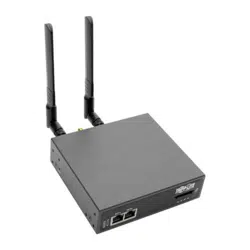Loading ...
Loading ...
Loading ...

141
7. Alerts, Auto-Response and Logging
SMS via Cellular Modem
To use an attached or internal cellular modem for SMS, the Administrator must enable SMS:
• Select Cellular Modem in the SMS Settings field.
• Check Receive Messages to enable incoming SMS messages to be received. A custom script will be called on receipt of
incoming SMS messages.
• You may need to enter the phone number of the carrier’s SMS Message Center (only if advised by your carrier or tech
support).
• Click Apply Settings to activate SMS SMTP connection.
Note: The option to directly send SMS alerts via cellular modem was included in the Management GUI in firmware version 3.4. Advanced
console servers have had the gateway software (SMS Server Tools 3) embedded since version 3.1. However, this can only be accessed from
the command line to send SMS messages.
7.5.3 Send SNMP Trap Alerts
The Administrator can configure the Simple Network Management Protocol (SNMP) agent that resides on the console server to
send SNMP trap alerts to an NMS management application:
• Select Alerts & Logging: SNMP.
Notes: In firmware versions 3.10.2 and above, new SNMP status and trap MIBS provide more and better-structured SNMP status and traps
from console servers. There is an option in the SNMP menu to Use Legacy Notifications for the SNMP traps. Selecting this option means
the console server will send SNMP traps that are compatible with those sent in older firmware before the new MIBS were added, ensuring
that the firmware upgrade will not disrupt existing SNMP management.
When upgrading from old firmware that does not support the newer SNMP MIBs/traps (versions before 3.10.2) to firmware that does
support the new MIBs/traps:
• If the SNMP service was enabled and an SNMP manager was configured before upgrading the firmware, the console server will be
configured to use the legacy traps after upgrading.
• If the SNMP service was not enabled or SNMP manager was not configured before the upgrade, then the console server will be configured
to use the new SNMP traps after the upgrade (this will not have any effect until the SNMP service is turned on and an SNMP manager is
configured).
• When starting up in the new firmware after a configuration erase, the console server will be configured to use the new SNMP traps.
• When upgrading from a firmware version that supports the new traps to a newer version that supports the new traps, the use legacy traps
setting should remain the same, as no checking on snmp service/manager configuration is needed.
• Select the Primary SNMP Manager tab. The Primary and Secondary SNMP Manager tabs configure where and how
outgoing SNMP alerts and notifications are sent. If you require your console server to send alerts via SNMP, then a Primary
SNMP Manager must be configured (at a minimum). Optionally, a second SNMP Network Manager with its own SNMP
settings can be specified on the Secondary SNMP Manager tab.
Note: All console servers can also be configured to provide status information on demand using snmpd. This SNMP agent is configured
using the SNMP Service Detail on Alerts & Logging: SNMP (refer to 15. Advanced Configuration for more information).
Loading ...
Loading ...
Loading ...
